OFFICIAL: OIL LEAK GUIDE
Posted: Thu Jun 16, 2022 2:02 pm
This is going to be the mother of all "oil issues" responses, mainly because I've seen entirely too many of these in the 5th gen thread.
H22's like to consume oil, and it is a well-known fact in the H-series community. From leaky seals, to FRM cylinder walls wicking oil into the combustion chamber, to bad valve seals- you are going to have to do a LOT of work if you want to cut down on your oil consumption. I've been in the position that many new 'Luders are in (not making much money and trying to repair my car), so I thought I would compile a list of things to do- from easiest/cheapest, to hardest/most expensive. Here is a link to the Helms manual download to help you along the way.

________________________________________
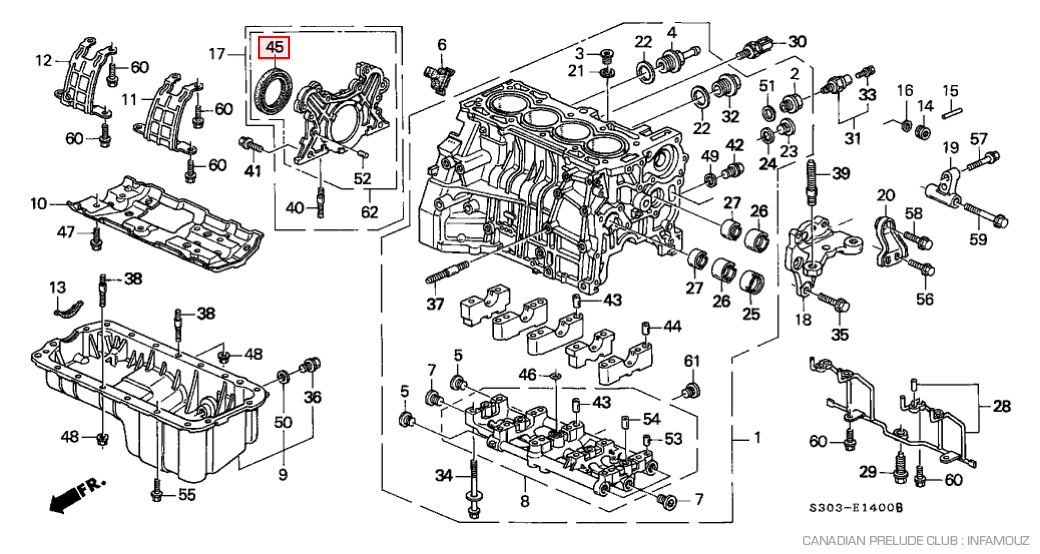
----
Courtesy of MommysLittleMonster
H22's like to consume oil, and it is a well-known fact in the H-series community. From leaky seals, to FRM cylinder walls wicking oil into the combustion chamber, to bad valve seals- you are going to have to do a LOT of work if you want to cut down on your oil consumption. I've been in the position that many new 'Luders are in (not making much money and trying to repair my car), so I thought I would compile a list of things to do- from easiest/cheapest, to hardest/most expensive. Here is a link to the Helms manual download to help you along the way.
- Seal it: If your car leaks oil, do something about it- replace the seals on the motor. Staring at them intently and wishing they would go away will not solve your problem.
- VTEC Solenoid Gasket: This is perhaps the biggest culprit for stock H22's. The VTEC Solenoid is located just behind your distributor, with the small cylinder sticking out of the top of it. It will require you to remove a few 10mm bolts. Oil will drain out of it, so get ready with some rags or a catch can.
HOW YOU CAN TELL: There will be oil/black gunk on the top of your transmission casing, and along the passenger side of the block.
COST: Gaskets are usually ~$20.. from your local dealer.
Part #15825-P13-005
Shown as #13 & #16 on the diagram:

- Distributor O-Ring: Like that creepy old guy that hangs out around schools, this little number is well-hidden. Often times, what happens is the O-ring will dry out after sitting for a while, crack, and then leak oil. To get to the seal, you need to remove the distributor from the cylinder head. Remove the three 8mm bolts from the distributor cap, remove the rotor by taking the setscrew out of the shaft (you may need to click the motor over until you can see this set screw), and unbolt the distributor from the shaft.
HOW YOU CAN TELL: There will be oil leaking on the passenger side of the block, typically black gunk will be pooled on top of your transmission.
COST: Typically ~$2.
Part #30110-PA1-732
Shown as #8 in the diagram:
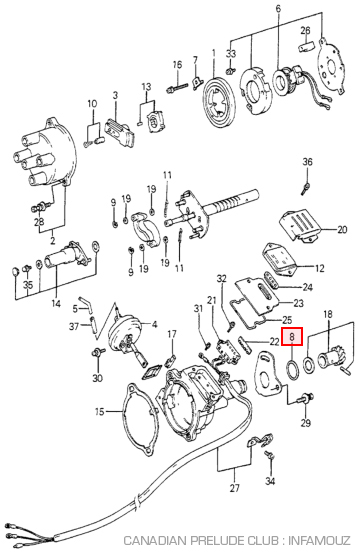
- Valve Cover Gaskets: Not quite as likely as the VTEC solenoid gasket, valve covers do in fact leak. This is the giant cover over the top of your engine, and is quite easy to remove. There are a few 10mm crown nuts you'll have to remove, then lift off of the top of the cylinder head. You can use a wide flat-blade screwdriver to help start pry it off. It's also advised to put a little high-temp silicone (Hondabond) in the sharp corners of the valve cover gasket, as they don't like to seal very well by itself. It's also a good idea to replace the spark plug well seals, too- they're the funny little guys that look like small rubber donuts. (NOTE- if you are mechanically inclined and your engine has many miles on it, you can also do a Valve Adjustment while you have the cover off. Link to writeup: viewtopic.php?f=37&t=126
HOW YOU CAN TELL: There will be oil/black gunk around the base of the valve cover, usually on the back or sides of the block.
COST: Valve cover gaskets are usually ~$15, the small rubber seals for the sparkplug wells are ~$3 each.
Part #12341-P13-000 (cover gasket)
......#12342-PT2-000 (rubber seals for s.p.w.)
Shown as #3 & #4 on the diagram.
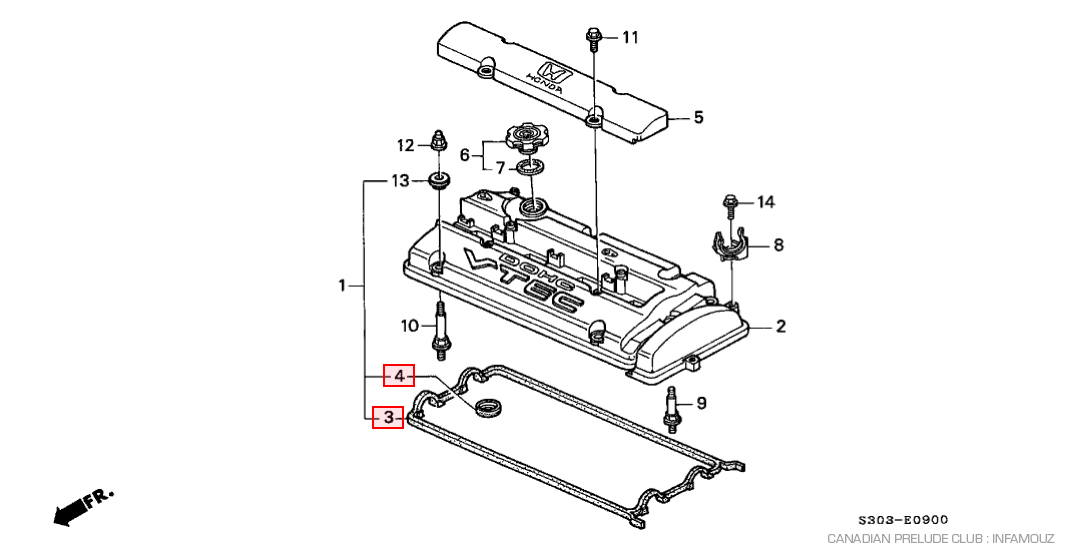
- Oil Cooler O-Ring: This guy is in a different area code in comparison to the last few seals mentioned, but is still a pain in the ass. This seal goes between the oil cooler and the block on an H22, and sometimes goes bad from heat cycles or age and cracks. This will cause you to dump all of that nice 10w-30 oil that you just changed all over your driveway, your exhaust, and everything south of the boarder. It will require that you use a 30mm deep-well socket to remove the oil cooler, and a torque wrench to torque it down to 54lbs-ft.
HOW YOU CAN TELL: Your mom will be screaming at you for dumping your oil on her driveway, and oil will be leaking from behind the oil filter and the block. Typically can be seen dripping into your axles and flex pipe.
COST: This little guy will run you about $4.
Part #91316-PE7-730
WRITEUP LINK: http://www.preludepower.com/forums/show ... p?t=324248 (props to xxfallacyxx)
Shown as #30 in the diagram:
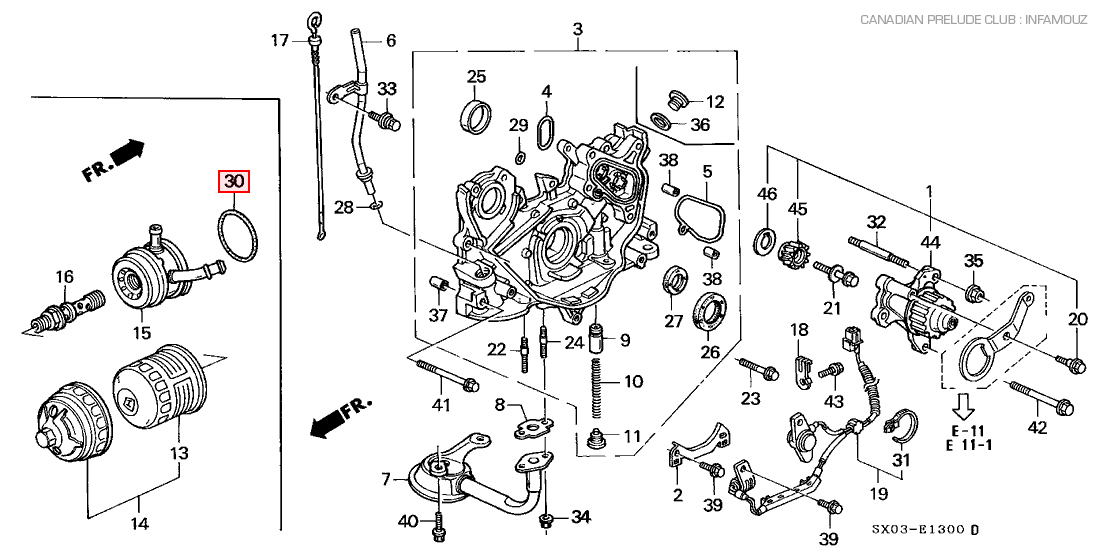
- Cam Cap Seals: A close relative to the VTEC solenoid gasket & valve cover gasket, this little black plug is a pain in your ass in more ways than you can count. There are multiple O-ring replacements for these little guys (BLOX, Golden Eagle, Skunk2, ect), personally I think the billet seals with O-rings is a better idea. However, following the OEM ideology of this thread, you can buy OEM replacements. It's a wise idea to use Hondabond sealing agent (although any high-temp sealer will work). You need to remove the valve cover, then remove the cam cap on top of it. Once the cam cap is off, you can replace the leaky bastard with a new one. BE SURE TO TORQUE THE CAP TO 7lbs-ft USING A TORQUE WRENCH!
HOW YOU CAN TELL: There will be black gunk/oil on the passenger side of the block, behind/next to the VTEC solenoid
COST: ~$7 from your dealership, ~$20 for an aftermarket replacement
Part #12513-P30-000
Shown as #8 in the diagram:
- VTEC Solenoid Gasket: This is perhaps the biggest culprit for stock H22's. The VTEC Solenoid is located just behind your distributor, with the small cylinder sticking out of the top of it. It will require you to remove a few 10mm bolts. Oil will drain out of it, so get ready with some rags or a catch can.

________________________________________
- All Other Major Seals: Most other seals beyond this point require major disassembly on your motor. If you are going this far, it is advised to do a full timing belt service while you have it apart. So, ask your mom if you can borrow the minivan for the weekend, or fire up your winter beater- because this is gonna get bumpy. Link to writeup for timing belt job/disassembly for jobs from here on out. Courtesy of JLUDE.
- Cam Shaft Seals: UNLIKE cam cap seals, these hard plastic pipsqueaks are located under the valve cover, behind the cam gears, on the cylinder head. This will require that you remove the cam gears- meaning you need to remove the timing belt. Once the cam gears are removed, you can remove the seals with a small, flat-blade screwdriver and a little work. You can insert the new seals by sliding them over the cam shafts, and pushing them gently on with the cam gears. (NOTE- MAKE SURE THERE IS GREASE ON THE INSIDE OF THE SEAL. All OEM Honda seals come with grease pre-loaded in the seal, to prevent a dry start and premature wear of the seal)
HOW YOU CAN TELL: There will be oil leaking down the front of the block, coming from the seals behind the cam gears.
COST: Typically ~$7 each from your Honda Dealership.
Part #91213-PR3-004
Shown as #38 on the diagram:
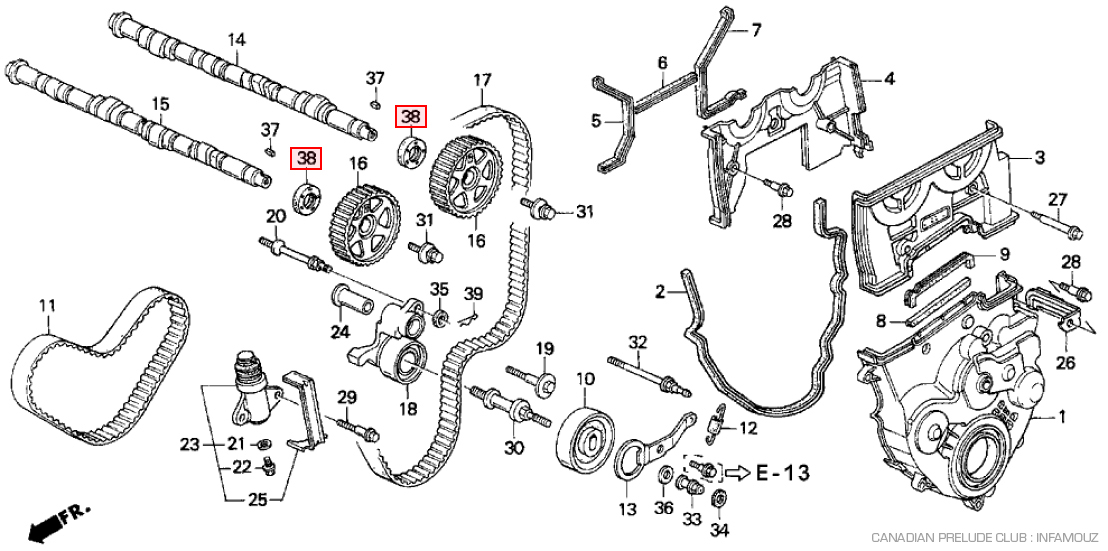
- Balance Shaft Seal: Like the cam seals, you will need to remove your timing belt and front engine cover to do these. These typically don't leak as much, but it is a good idea to get fresh seals while you are this far in. To remove these guys, you need to break the bolt loose on the end of the balance shaft (good idea to leave the belt on the shaft wheel before doing this) and remove the retainer. Once they are out of the way, it's the same as doing the cam shaft seals.
HOW YOU CAN TELL: Oil will be leaking from the seal, typically black and dirty underneath seal.
COST: About $5.
Part #91233-PT0-003
Shown as #27 on the diagram:
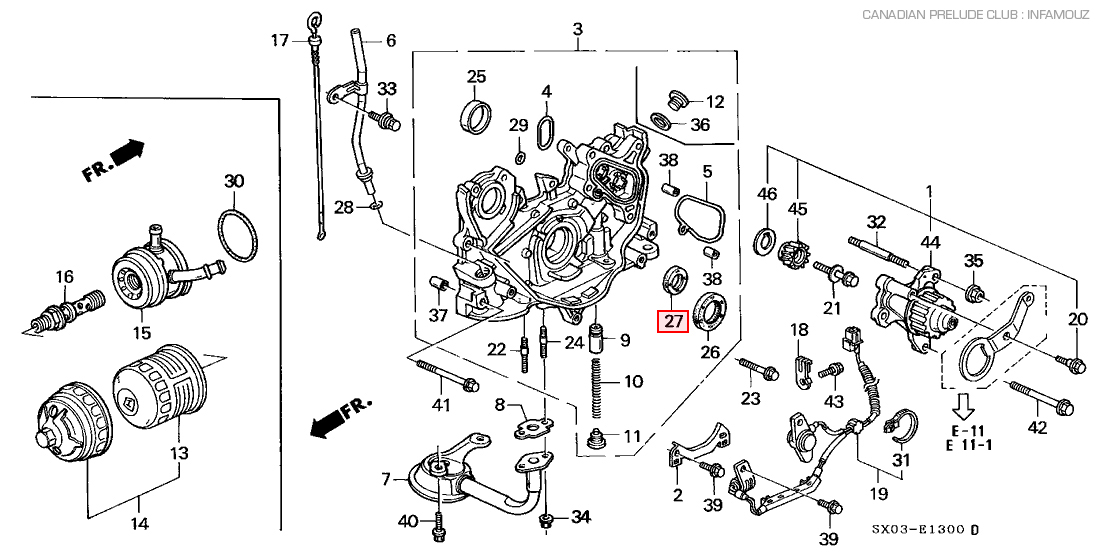
- Front/Rear Main Seals: The biggest bastards of them all, the front and rear main seals. The front main seal is located behind the crank pulley, while the rear main seal is buried behind the flywheel on the back of the motor. If you're going this far, you might as well plan on investing in a new clutch too!
HOW YOU CAN TELL: Oil will be leaking between the transmission case and the engine block, or out of the bottom of the timing cover and onto the oil pan
COST: $15 for the rear, $15 for the front.
Part #91214-PAA-A01 (rear)
......#91214-PLE-003 (front)
Shown as #45 in the diagram:
- Cam Shaft Seals: UNLIKE cam cap seals, these hard plastic pipsqueaks are located under the valve cover, behind the cam gears, on the cylinder head. This will require that you remove the cam gears- meaning you need to remove the timing belt. Once the cam gears are removed, you can remove the seals with a small, flat-blade screwdriver and a little work. You can insert the new seals by sliding them over the cam shafts, and pushing them gently on with the cam gears. (NOTE- MAKE SURE THERE IS GREASE ON THE INSIDE OF THE SEAL. All OEM Honda seals come with grease pre-loaded in the seal, to prevent a dry start and premature wear of the seal)

----
Courtesy of MommysLittleMonster